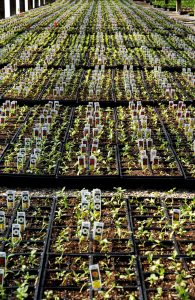Photos by L.G. Patterson
As we anticipate the official first day of summer and longest day of the year on June 20, be sure to start planting well before to enjoy the spoils of your hard work
all summer long!
You also don’t need to wait until Missouri’s 90-degree temperatures — weather that makes anyone want to wilt — greet us to prep and plant. A good rule of thumb is to wait until after the first frost if you aren’t sure or feel nervous about plant survival. The region’s last frost tends to happen around early-to-mid May.
Regardless of when or what you decide to plant, both flower and vegetable gardens can be tricky. We’ve talked to local experts to help take your garden into full bloom whether you’re a beginner or a well-acquainted green thumb.
Prepping the ground for your plants is one of the most important keys to the longevity of your garden this summer. According to the Missouri Department of Conservation, Missouri clay soils dominate the state, meaning when working with this type of soil prepare for it to be “sticky when wet, form hard lumps when dry, and crack in hot weather. Sandy soils let moisture drain away quickly, taking nutrients with it.” With many nutrients stripped away from the soil before you place plants in, you’re starting off behind.
Laying topsoil will help in dealing with Missouri clay and help plants soak up the proper nutrients to grow when combined with organic matter; many times, organic matter will be found in bags of topsoil. If you’re working with a raised garden bed or looking to lift your flowers up from the ground, it works as a great filler. Mulch is used to help keep the ground cooler by retaining wa- ter for those areas that might be in more direct sunlight and by controlling weeds.
Compost helps fertilize your plants and gives them nutrients they need when working with Missouri’s clay soil. Compost comes from different types of waste — leftover food, animal waste, yard trimmings, cardboard and scraps of paper, paper napkins, coffee and tea. The waste has been heated up to break down each matter’s nutrients, creating a combined form that is easy for plants to absorb. Gaining popularity is composting from your home with either a kitchen compost bin or an outdoor compost tumbler. Both have pros and cons.
Kitchen bins are easily accessible and tend to be smaller compared to outdoor tumblers. Yet, they can fill up quickly and create a permeating smell throughout the room. Outdoor tumblers hold more, and if situated in the light, can heat up quickly. You will need to turn it approximately once a week for waste to fully mix, which can be a con for those who might forget.
BlueBird Composting, located north of Columbia and in Fulton, cultivates organic compost and soils from scratch. Becky Seitz, BlueBird’s office manager, recommends mixing top- soil and compost to give your plants the best outcome.
“We sell a lot, a lot of our compost topsoil blend because it’s 40% compost and 60% topsoil, so you can plant right into it,” Seitz says. “You can plant flower seeds, you can plant vegetable seeds or start small plants. And companion planting is yet another step.”
Companion planting places herbs next to vegetables or flowers so that each plant mutually benefits. The benefits can include keeping weeds out of a bed or protecting certain plants from unwanted bugs.
“Starting small is probably going to be the most successful for people, especially if they’re just starting out,” Seitz says. “Because it’s so easy to build and grow with the imagination when you’ve had a successful planting or garden crop.”

Whether you’re a beginner or a seasoned vegetable gardener, one way to prep your bed on planting day is by watering thoroughly.
“Water is the most essential ingredient,” says Steven Sapp, co-owner of Strawberry Hills Farms. “We recommend digging the hole for your plant, then adding a lot of water before you fill in soil around the roots. Water in the hole pro- motes root stability and root growth down and out, not up toward the surface. This makes for a faster growing and healthier plant.”
For beginners, Sapp says they sell tomatoes and peppers the most out of their vegetable options. Both are hearty enough to grow in the sum- mer. Though if salads are what is de- sired, then lettuce, kale and spinach grow best in cooler season — spring and fall — to fully flourish. Raised beds also don’t have to be the standard. Container growing is also an option for those with not much space and for controlling the plant’s environment, he states.
His three major tips for beginners are “don’t be afraid to try to grow something new, be patient to let the weather warm up before planting things like tomatoes and peppers, and be ready to put in some sweat and muscle.”
For seasoned vegetable gardeners, attempting their gardening prowess with other vegetables can always be a fun challenge. Especially, as Sapp states, the more vegetables in the garden, the more luck you will have for a successful crop. “Although in vegetable gardening nothing comes as easily as one might hope,” he says. “There is always the potential for wind, drought, disease and insects, just to name a few of the obstacles that can get in the way.”
Strawberry Hills Farms offers numerous options for vegetable gardeners, so if individuals are looking to diversify their plants out- side of staples, they offer options such as sweet potatoes, burpless cucumbers, eggplant, as well as yellow summer squash.
“Even though I know not all of our customers are going to be successful with their gardens each year, it is exciting to see how many want to give it a go and enjoy the process that comes with growing your own food,” Sapp says.
For those gardeners hoping to bring some life to the outside of their homes, flower gardening can be a colorful answer. Though, the first question to ask yourself is: will it be annual or perennial?
Annual flowers and shrubs will grow for one season and one season only. Perennials will come back for multiple seasons.
If individuals are wanting color in their gardens or yards, then annuals are the way to go. An annual produces more seed in its attempt to continue growing past its short-lived time stamp. Helmi Sheely, owner of Helmi’s Gardens, says, “Perennials have a bloom time and have periods where they are not blooming while storing energy. Most annuals bloom the entire season, they usually provide more color over the season, but annuals need to be replaced every summer.”
She recommends annuals such as lantanas or petunias since they will have quite a bit of color while in bloom and are easy to take care of.
For perennials, the U.S. Department of Agriculture’s Plant Hardiness Zone Map serves as a general guide for growing.
According to the USDA’s website, the map is “based on the average annual extreme minimum winter temperature.” Mid-Missouri is in zone 6b. The zone numbers typically are displayed next to a perennial plant’s description.
If you start early enough, a spring bulb like a daffodil will bloom earlier than other perennials, so staggering multiple perennials allows you to have constant color throughout the spring and summer.
Sheely says that a current trend is planting native plants. Many gardeners want to grow them to help the environment, assist different species of insects, etc. Yet, a native plant to Missouri doesn’t always mean it will work where you want to plant it. For instance, growing butterfly weed, a perennial, to help monarch butterflies is popular, yet as Sheely says, “The actual place that it grows in Missouri is really a climate- specific microclimate. Throwing it in your yard is not that microclimate. I think natives are a great idea. I think you have to plant natives in the right spot.”
Some advice she gives gardeners or those looking to plant even one or two plants is, first, to make sure if you’re planting in pots that they are big enough. Second, the internet is not always good advice. Find someone who has experience. And finally, set yourself up for success in what you choose to plant, because when your garden succeeds “you feel brilliant.”




















